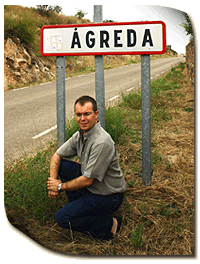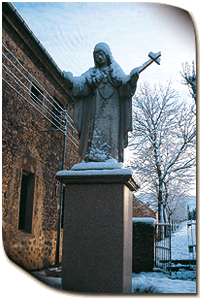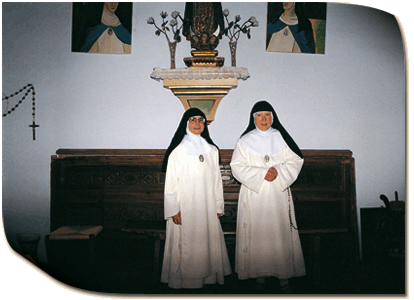The Inspiration for The Lady in Blue - Javier Sierra

The dedication to The Lady in Blue contains an enigmatic reference to the date of April 14, 1991. Why did Javier Sierra choose to cite this date at the very beginning of his novel? What follows is the author’s own marvelous, magical explanation.
“…Thirty-eight years later (1631), the Holy Inquisition would detain the nun María de Ágreda, who claimed to have made more than 500 voyages to the New World to evangelize the pagans. As far as is known, the nun never left her convent during the previous eleven years. Nevertheless, when missionaries reached the Jumano Indians of New Mexico to Christianize them, the tribe was already familiar with the Catholic faith. To Alonzo de Benavides, their Superior, they confessed that it had been a nun matching the physical description of Sister Ágreda who had instructed them in the Gospels… “
I never thought that Fate —which Sophocles said “guides whoever willingly follows it”— would force me to return to this paragraph repeatedly over a period of seven years. I included it as the afterward in a piece I published in February 1991, in the Spanish periodical Año Cero. Back then I was a precocious journalist, merely nineteen years old, eagerly searching out curious, strange stories that I’d put to paper. And that was one of them, but not just any one, as it turned out.
Let me explain.
I discovered the strange case of Sister Maria de Ágreda almost by accident. One day, browsing through a carton full of papers that a friend had left me, I found an old Mexican weekly. It was in bad condition, dirty and wrinkled, but nevertheless I resisted throwing it out before having a glance at it. Now I know I was right. An article inside, ravaged by time and humidity, caught my attention immediately. It recounted the adventures of a cloistered Spanish nun from the 17th century, who, thanks to her gift of bi-location, had been attributed with evangelizing New Mexico, Arizona, and Texas. I’d never read anything like it. The weekly affirmed, moreover, that it was God who had granted her the power of being in two places at once in order to augment the dominions of Christianity.
The story, of course, fascinated me. And even though it was peppered with imprecise information (it didn’t clarify the place of origin of the nun, or the Spanish convent in which she resided), something compelled me to investigate further.
There was a great story somewhere in all this, I could feel it. A trail I had to follow.
Perhaps it was that instinct that led me to mention that nun in my article. I took what little plausible information it contained and with it I knocked off an article on a subject more or less as strange as bi-location: teleportation. That is, the theoretical possibility of transmitting matter instantaneously from one point in the universe to another. Had something similar happened to Sister María de Ágreda four-hundred years earlier? Theoretical physics had been toying with such ideas for some time now. In such science fiction series as Star Trek it was managed effortlessly. Some scientists had even managed to transmit the “quantum state” of one photon to another, across the cosmic distance of 90 centimeters. And there were no lack of individuals, from each of the five continents, who claimed to have been transported inexplicably but instantaneously from one geographical location to another right after penetrating a mysterious fog or experiencing a glacial chill.
My article was dedicated to them, and at the end of the piece I cited the “Ágreda case,” with the intention of showing that we weren’t faced with simply a modern urban legend, but rather with an age-old historical phenomenon.
At the mention of María de Ágreda in my article I had miscalculated the risks. It was as if there had unleashed some mysterious force that had been dormant for centuries, waiting for someone who would awaken it. Only that could explain why, without intending to, I ended up getting totally wrapped up in the true, incredible, and entirely bewildering story of this forgotten nun from a Spanish convent.
Our encounter would change my life.
Two months after the publication of my piece, I had already embarked upon an entirely different investigation. My efforts to learn more about that María de Ágreda had borne no fruit. Tired of my failures, I decided to abandon my investigation for something more promising. I proposed instead to search for as many copies of the Holy Shroud of Turin as had arrived in Spain between the 17th and 18th centuries. I had no idea what exactly I was going to come up with regarding them. Perhaps the workshop that supposedly falsified the original Shroud in the 13th century. Or maybe the proof of its authenticity. The fact is that the hunt for those relics throughout a number of ancient rural parishes all across Spain kept me, for a while at least, completely distracted from the “Ágreda case.”

On April 14, 1991, my new investigation reached its height. I was taking two weeks to travel around half of Spain, and upon reaching the northern part of the peninsula I felt very close to my objective. The previous night it had snowed heavily in Pamplona, and nearly all the highways on my route had been covered with ice for hours. My car was not prepared for such weather. I had no chains for the tires, and the motor was scarcely warm enough to heat the interior. To top it off, I was completely lost. Txema Carrasco, a bookseller from Bilbao who was accompanying me on my quest, began to get nervous. A mistake in reading the map had put us at a great distance from the principal highways.
That is when it happened.
In the midst of the storm, with the windshield wipers going full speed, the sign marking the entry to a town left me suddenly breathless. In my log book I wrote: “14th of April, 1991; 10:40 a.m. Arrived at Ágreda.”
Ágreda?
Ágreda!
For a few seconds I was completely absorbed by that sign. It was one of those moments when time seems to stop. But finally I understood everything. Fate -–that “Guide” to which I alluded a few lines above-— had made us veer from our route, leading us to the very place where the story of the bi-located nun had originated. What else could I think?
For many years this fortunate coincidence would continue to obsess me.
In 1991 there were 35,618 towns in Spain. To end up by chance at the only place that could have helped me solve the mystery of the bi-located nun was a total miracle. Something was going to happen there, I was sure. That sign that had left me stunned contained a great lesson: that the only “key” to unlock the case of the bi-locating nun had been right in front of my eyes the whole time. And it was her name: Sister María de Ágreda.
This Ágreda wasn’t a family name, it was her place of origin!
It was as if a cyclone had shaken my insides.
I jumped out of the car possessed, urging Txema to help me confirm what until that moment was only a fleeting supposition: that this had to be the town of Sister María. How could I have been so dense? How could it not have occurred to me to check whether in the remote province of Soria there existed a town with that name?
Txema and I set out to find the town’s priest, knocking on the doors of churches and scouring every corner of the village. Everything was closed. Empty. The streets of Ágreda, as if they wished to guard some secret of their own, remained deserted, their shutters closed. And the snow started to begin again in earnest.
It was no laughing matter. If we delayed in that town any longer, the ice would likely leave us stranded and without gas. Furthermore, being sensible, Txema and I had nothing “real” to do there. After talking for a minute, we came to a decision: we would abandon the town and our cursory search immediately, leaving that coincidence for our bag of anecdotes. Once we got back home, we would have some other occasion to pick up the thread again.
Agreed.
After checking our highway map once more to reorient ourselves, we decided to leave Ágreda and head for La Cuesta, a miniscule town in which tradition affirmed that one of the Holy Shrouds was found. What we could not have imagined was that another navigational error-—error?--was about to revise our plans forever.
Leaving Ágreda turned out to be not so easy. The weather had forced us to take a narrow, icy street, which we soon realized was a mistake. It was then that, as we were turning around, we saw it. Strangely enough, it hadn’t caught our attention until now, even though it had been there all along, hidden behind the snowdrift. Just to our left, only a few steps away, was a massive stone building flanked by the statue of a nun.
“What if…?”
I couldn’t finish the phrase. Txema, as excited as I was, interrupted me with a surprising revelation.
“I forgot to tell you something,” he muttered. “Perhaps it has nothing to do with your nun, but someone told me a while ago that the undecayed remains of some nun were preserved in this town… It wouldn’t surprise me if this was the place…”
“What did you say?”
The bookseller hesitated. “I’m not totally sure, but we might knock on that door and ask. Don’t you think?”
That mysterious building had all the markings of a convent. Its gratings and lattices, its church on one side and its uniform serenity, which said all. Incredulous, we approached what seemed to be its principal access, stooping to read what was written at the foot of the statue: “To the venerable Mother Ágreda, with reverent pride. Your fellow townspeople.”
That troubled me. To which Mother Ágreda did the marker refer? To the same one we were searching for? Or perhaps to the one whose incorruptible body Txema had just referred to? I wrote down the inscription before entering the reception of what, effectively, turned out to be the cloister of a monastery.

“Ave María Purísima.”
The fragile voice of a nun welcomed us from behind an impenetrable wooden barrier.
“Conceived without sin, Sister,” we responded.
“How may I help you?”
That frank hospitality relaxed us.
“You see, Sister” the snow has accidentally brought us here and, suddenly, upon seeing the name of the town, we were asking ourselves if this might be the place where a nun named Sister Maria de Ágreda lived… Would you happen to know?”
“How could we not know!” the woman behind the barrier replied proudly, “She is our founder!”
Txema and I gave each other a knowing glance. The ethereal “guide” of our journey had hit a bulls-eye. As it turned out, only a few minutes later we were standing before the grating of one of the convent's locutories, animatedly conversing with two of the nuns from that pious community. As if they had been waiting for us, with no preamble, both were willing to clear up some of our doubts.
“Yes, yes,” said the older of the two, Sister María Margarita, “in the church we have on display the uncorrupted remains of Sister María. Here we refer to her as the Venerable One. We used to house her in the gallery of the church, in our museum, but since 1989 she’s resided in the church proper, so everyone can see her.”
“And the miracles attributed to her, having to do with…?” I asked, prudently leaving the question in the air.
“Her powers of bi-location, sir,” my interlocutor replied amiably. “If it would interest you, we can read to you some pages from the life of la Venerable, where it describes this extraordinary phenomenon… Would you care to sit down?”
While she went to look for the book in question, Sister Ana María, the younger nun, approached the grating that separated us to relate something.
“You should know that our venerable sister María was wholly obsessed with the salvation of souls. She knew of the lack of missionaries in America and had the desire to evangelize that continent. But of course she was a cloistered nun…”
The more than two hours that Txema and I spent in the locutory with those nuns dispelled a good portion of our doubts. They confirmed that not only Sister María de Ágreda, the polemical nun with powers of bi-location, lived in this locale that bore her name, but that her body had been incorruptibly preserved within those walls. But I soon discovered that the clarifications of Sisters María Margarita and Ana María only revealed the tip of a vast, mysterious, and surprising iceberg.
“Do you know what they called her in America?”
At this question, Txema and I could only shrug our shoulders.
“The Lady in Blue. Isn’t that beautiful?”
“And why that name, Sister?”
Sister Maria Margarita smiled.
“Very simple: because the nuns from our order wear a blue mantle over our white habits. That must have drawn the special attention of the natives.”
That day, at that precise moment, my novel was born. And its title as well. But there were also a long series of trips around Spain and off to the North American states of Arizona, Texas, and New Mexico in search of the evidence for this case. To Indian reservations, to ancient Spanish missions, and even to the classes of several universities where I asked over and over about this Blue Lady. But after consulting private and public archives for seven long years, and drunk from Christian and heterodox sources to document my novel, I still hadn’t found the answers to my first questions: Why on that 14th of April were my steps halted in Ágreda? What strange threads were moved so that my journey would veer off in such a way, and end up in this remote Castilian village? And who again diverted our departure when Txema and I decided to abandon Ágreda after not having found anybody who could talk to us about Sister Maria? And who or what led us to the door of the convent in which the Lady in Blue had lived for forty-seven years in rigorous seclusion?
A mystery.
But just the kind of genuine mystery that serves as the seed for any good novel.
The Columbus Dispatch


